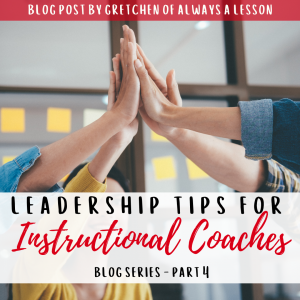Leadership Tips for Instructional Coaches- Part 4
This four-part series shares leadership tips for instructional coaches. Each subsequent post will be specific to an aspect of coaching. Part One shared generalized tips, Part Two discussed organization, professional growth, and teacher motivation/buy-in and Part Three focused on how to best support classroom instruction. This post is Part Four and discusses how to support communication among all stakeholders.
Communication
 District personnel, school building administrators, teacher leaders, classroom teachers, students, parents and community members are considered important stakeholders. It is essential to create systems to communicate with each group of stakeholders as it relates to their role in education, meaning what you communicate to parents is very different and what you share with the principal.
District personnel, school building administrators, teacher leaders, classroom teachers, students, parents and community members are considered important stakeholders. It is essential to create systems to communicate with each group of stakeholders as it relates to their role in education, meaning what you communicate to parents is very different and what you share with the principal.
This post focuses on communication between the instructional coach (also called facilitator, teacher leader, curriculum developer, specialists, etc.) and the classroom teacher. Below are 10 aspects of communication to consider as the instructional coach:
- Assign Team Roles– To ensure all voices are heard during meetings (planning, PLC and data digs, PD sessions, etc.), assign team roles. They can alternate each meeting, but ensure everyone has a role when it comes to communication. Examples include: Presenter, Synthesizer, Note-taker, Question Asker, etc.
- Ask Better Questions– To get to the root of any problem, you have to dig deep. The only way to go deep is to continue to ask good questions. Remove judgment and assumption. Listen intently and collect information to help you better support teachers.
- Be a Bridge– You are a connector between administration and classroom teachers. Be a bridge so communication remains clear and all voices are heard and understood.
- Build Connections– Authentic connections allow you to truly get to know teachers as people first and professionals second. It removes barriers to trust and willingness to receive help. Communicating in a natural way builds strong connections with stakeholders.
- Create a Communication Pathway- Over-communication can create overwhelm for receivers and the message often gets distorted, just like a game of telephone. Design the pathway for who shares communication with whom and in what order. This structure will ensure clear communication is delivered every time.
- Develop Norms and Non-Negotiables– To facilitate strong communication among all stakeholders, establish norms and non-negotiables to hold each other accountable. Items could include professionalism (prompt arrival, polite discourse, proper dress, etc.), regular contribution (share suggestions, strategies, and ideas) and more!
- Facilitate, Don’t Dictate– As a teacher support, you are a guide to their professional development. When you tell teachers what to do and how to do it, they begin to resist. When you facilitate (ask questions and make suggestions), you are able to push them in the right direction instead of push them to do something your way on your time table.
- Provide Input– The role of a instructional coach is to guide teachers to reach their growth potential. There are very few times you’ll provide direct feedback (ie. observation). The majority of your support will be sharing input in the forms of questions and suggestions rather than necessary next steps or performance ratings.
- Seek to Understand– My friend Andrea Battle called this teacher leadership skill an “understanding undershirt.” It is underneath everything you do in supporting teachers. When you operate from a place of understanding, you are respected and are able to produce results because you access the root of the problem and work up from there.
- Utilize Communication Frameworks– Develop discussion starters, sentence stems, and guiding questions so when you meet with teachers you can use your energy to be present in the conversation rather than thinking about what to ask and how to ask it.
NEXT STEPS
- Continue to follow this blog series for more leadership tips for instructional coaches (Read Part One, Part 2 & Part 3).
- If you’d like to dig in on a deeper level, you can gain professional development (and credit towards your teaching license) through the “Teachers Who Lead” course bundle.
- Get access to more instructional coaching resources and professional development resources below:
Go Be Great!
What leadership advice do you have for instructional coaches?



